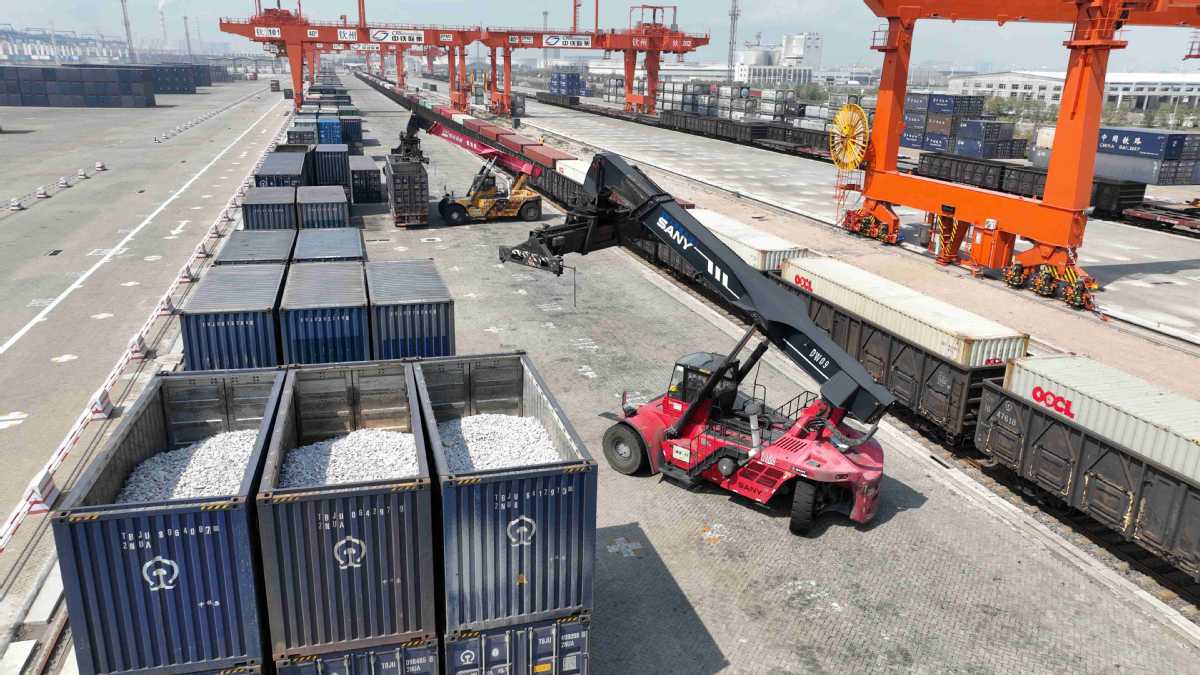Trade corridor boosts China, ASEAN biz integration

Machinery is seen moving containers at a port in Qinzhou, Guangxi Zhuang autonomous region, in March. [Photo/Xinhua]
NANNING-X9575, a freight train departing from Chongqing municipality in Southwest China, arrived at Qinzhou Port East Station in South China's Guangxi Zhuang autonomous region on Monday.
Loaded with goods such as auto parts, chemicals and Chinese foods from regions along the land-sea freight route-part of the new International Land-Sea Trade Corridor-X9575 transfers at the Qinzhou Port, where the cargo will be shipped to Association of Southeast Asian Nations (ASEAN) member states.
"It used to take about a month for commodities from western regions to reach ASEAN member states via the Yangtze River and sea route," said Liang Yu, deputy head of the station. Now cargo consigned in Chongqing can be delivered to Vietnam through the corridor in just four days, Liang said.
Launched in 2017, the new International Land-Sea Trade Corridor is a trade and logistics passage jointly built by western Chinese provinces and ASEAN member states.
With Chongqing as the transportation hub, the corridor uses ports in Guangxi's Beibu Gulf to reach ports in Singapore and other ASEAN member states, and links China-Europe freight trains setting off from many western Chinese cities before heading to Central Asia, South Asia and Europe.
The corridor saw 379,000 twenty-foot equivalent unit (TEU) containers transported by the railway's intermodal freight trains in the first six months, up 33.4 percent year-on-year, said the China Railway Nanning Group Co Ltd.
The corridor, covering 14 provincial-level regions in China, has expanded its reach to 319 ports in 107 countries and regions.
Speaking of the corridor at the 12th Pan-Beibu Gulf Economic Cooperation Forum held in Nanning, capital of Guangxi, earlier this month, Basilio Dias Araujo, deputy for Maritime Sovereignty and Energy, Coordinating Ministry for Maritime Affairs and Investment of Indonesia, said it has brought more opportunities to the connectivity between China and ASEAN.
Basilio added that as a maritime country, Indonesia is also happy to join in the construction of the corridor, and strengthen cooperation with ports along the route, including the Beibu Gulf Port.
The Beibu Gulf Port, which comprises the ports of Qinzhou, Fangcheng and Beihai, serves as an important transit point in the new International Land-Sea Trade Corridor. In the first half, the port saw its cargo throughput rise 6.95 percent year-on-year to 139 million metric tons.
In April, Gansu province signed a memorandum of understanding (MoU) with Thailand to boost trade and strengthen bilateral relations.
Jurin Laksanawisit, Thai deputy prime minister and commerce minister, said the signing of the MoU fully reflects Thailand's expectations to further develop the economy within the region and achieve common prosperity through the corridor.
Official data showed that over the past five years, the trade volume between the regions and cities along the corridor in China with ASEAN has continued to rise, up from $58.9 billion in 2017 to $107.7 billion in 2021.
Photos
Related Stories
- ASEAN needs to stand in unity for regional peace, stability, sustainable development: Cambodian PM
- Across China: Tourism featuring ASEAN cultures heats up in border region
- China, ASEAN media and think tanks discuss global development
- Cambodian FM says ASEAN committed to ensuring RCEP implementation
- ASEAN foreign ministers vow to strengthen bloc's centrality, credibility: joint communique
- China strengthens ties with Asian countries during pandemic: report
- 55th ASEAN foreign ministers' meeting, related meetings kick off in Cambodia
- Post-pandemic recovery, inflation, security high on agenda at 55th ASEAN foreign ministers' meeting
- RCEP facilitates ASEAN products' access to Chinese market
Copyright © 2022 People's Daily Online. All Rights Reserved.









